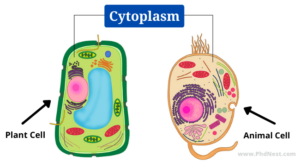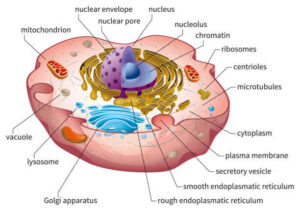Cytoplasm Description
In cell biology, the cytoplasm is all of the material within a eukaryotic cell, enclosed by the cell membrane, except for the cell nucleus. The material inside the nucleus and contained within the nuclear membrane is termed the nucleoplasm. The main components of the cytoplasm are:
- Cytosol (a gel-like substance).
- The organelles (the cell’s internal sub-structures).
- Various cytoplasmic inclusions.
The cytoplasm is about 80% water and is usually colorless.
Cytoplasm Definition
- The cytoplasm is the cell’s semi-viscous ground substance.
- Cytoplasm is the volume of such a substance outside the nucleus and within the plasma membrane.
- It is sometimes referred to as the protoplasm’s non-nuclear component.
- In prokaryotes, the cytoplasm holds all of the cellular contents.
- The nucleus and cytoplasm of eukaryote organisms are separated.
- The cytoplasm is the life material; it functions as a molecular soup in which all of the cellular organelles are suspended and held together by a lipid bilayer membrane.
- Robert Brown and other scientists discovered the cytoplasm in the year 1835.
Cytoplasm Structure & Components
The following are the primary components of the cytoplasm:
- A gel-like material called cytosol
- Organelles are internal sub-structures of the cell, as well as
- Various cytoplasmic inclusions.
The Cytosol
The cytosol is the cytoplasmic space that is not filled by any organelle. It’s a gelatinous fluid in which other cytoplasmic components are suspended. The cytoskeleton filaments, organic molecules, salt, and water make up the majority of it.
Cytoplasm Diagram
Organelles
The term “organelles” refers to membrane-bound “little organs.” They exist within the cell and perform specialised duties that are required for the cell’s survival. In plant cells, cellular organelles such as mitochondria, endoplasmic reticulum, Golgi apparatus, vacuoles, lysosomes, and chloroplasts are among the elements suspended in the cytoplasm.
Cytoplasmic Inclusions
Different forms of insoluble particles or molecules that remain suspended in the cytosol make up cytoplasmic inclusions. There is no membrane surrounding cytoplasmic inclusions. They are essentially starch and glycogen granules that can store energy. Different cell types have a wide variety of inclusions.The inclusions range from calcium oxalate crystals or silicon dioxide crystals found in plants to starch, glycogen, and other storage granules. Lipid droplets are a common type of inclusion; they are spherical droplets made up of lipids and proteins that are found in both prokaryotes and eukaryotes as a storage medium for lipids such as fatty acids and sterols.
Click Here for Complete Biology Notes
Properties of Cytoplasm
- The cytoplasm is normally whitish and made up of 70–80 percent water.
- Proteins, carbohydrates, salts, sugars, amino acids, and nucleotides are all found in it.
- The cytoplasm is made up of dissolved nutrients as well as waste materials.
- The ectoplasm, or cell cortex, is the exterior transparent and glassy layer of the cytoplasm, while the endoplasm is the inner granular mass.
- The plasmogel is a thick, jelly-like material found in the cytoplasm’s periphery zone. The plasmosol surrounds the nuclear zone and is thin and liquid in form.
- The cytoplasm has a wide range of physical characteristics. The cytoplasm can sometimes resemble a colloidal solution due to rapid diffusion across the cell. It appears to take on the qualities of a gel-like or glass-like substance at other times.
- It is believed to have both viscous and elastic qualities, being capable of deforming slowly under external force while also recovering its previous shape with minimal energy loss.
- The cytoskeleton in the cytoplasm is responsible for the cell’s form.
- Through a process known as cytoplasmic streaming, cytoplasm aids in the transfer of cellular components around the cell.
- The cytoplasm is an excellent conductor of electricity because it contains many salts.
- It has different staining properties; the basophilic parts of the cytoplasm are stained with basic dyes, and this material is called ergatoplasm.
How to increase Brain Power – Secrets of Brain Unlocked
Cytoplasm Functions
- Most of the cell’s enzymatic reactions and metabolic activity take place in the cytoplasm.
- The cytoplasm is the area of the cell where it swells and grows.
- The cytoplasm acts as a suspending medium for the organelles.
- The cytoplasm serves as a buffer, protecting the cell’s genetic material and cellular organelles from damage caused by movement and collision with other cells.
- The first step in cellular respiration is glycolysis. The intermediates produced by this process are utilised by the mitochondria to generate ATP.
- The cytoplasm is also where mRNA is translated into proteins by ribosomes.
- The monomers that make up the cytoskeleton are also found in the cytoplasm. The cytoskeleton is essential for cells with particular shapes, in addition to being required for typical cell functions.
- The cytoplasm also helps to maintain order within the cell by providing particular sites for various organelles.The nucleus, for example, is frequently found towards the cell’s centre, with a centrosome close.
- Cytoplasmic streaming is necessary for placing chloroplasts near to the plasma membrane and spreading nutrients throughout the cell. Cytoplasmic streaming is thought to play a role in the creation of cellular sub-compartments and organelle location in some cells, such as mouse oocytes.
- Cytoplasmic Inheritance: The chloroplast and mitochondria are two organelles in the cytoplasm that have their own genomes. These organelles are inherited directly from the mother via the oocyte, and hence are genes that are passed down outside of the nucleus. These organelles multiply outside of the nucleus and respond to the cell’s requirements.
Cytoplasm Citation
- Stephen R. Bolsover, Elizabeth A. Shephard, Hugh A. White, Jeremy S. Hyams(2011). Cell Biology: A short Course (3 ed.).Hoboken,NJ: John Wiley and Sons.
- Alberts, B. (2004). Essential cell biology. New York, NY: Garland Science Pub.
- https://biology.tutorvista.com/animal-and-plant-cells/cytoplasm.html
- https://biologywise.com/structure-functions-of-cytoplasm
- https://biologydictionary.net/cytoplasm/
- http://www.softschools.com/science/biology/function_of_cytoplasm/
Related Posts
- Phylum Porifera: Classification, Characteristics, Examples
- Dissecting Microscope (Stereo Microscope) Definition, Principle, Uses, Parts
- Epithelial Tissue Vs Connective Tissue: Definition, 16+ Differences, Examples
- 29+ Differences Between Arteries and Veins
- 31+ Differences Between DNA and RNA (DNA vs RNA)
- Eukaryotic Cells: Definition, Parts, Structure, Examples
- Centrifugal Force: Definition, Principle, Formula, Examples
- Asexual Vs Sexual Reproduction: Overview, 18+ Differences, Examples
- Glandular Epithelium: Location, Structure, Functions, Examples
- 25+ Differences between Invertebrates and Vertebrates
- Lineweaver–Burk Plot
- Cilia and Flagella: Definition, Structure, Functions and Diagram
- P-value: Definition, Formula, Table and Calculation
- Nucleosome Model of Chromosome
- Northern Blot: Overview, Principle, Procedure and Results


















